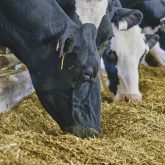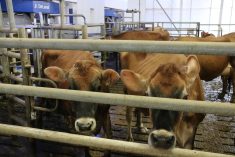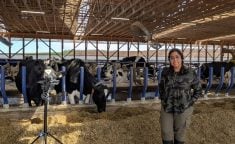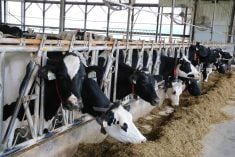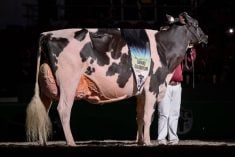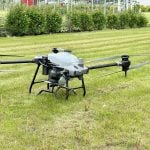Two companies that monitor cattle with boluses in the animal’s stomach continue to fine-tune algorithms and extend the age of animals for which their products can be used.
Guelph-based Cattlescan was at the Canadian Dairy XPO in Stratford, Ont. April 5 and 6 promoting its research into the use of boluses in calves.
Why it matters: The marketplace for early dairy disease detection through sensors is becoming increasingly crowded so companies must continually add value to remain competitive.
Cattlescan’s original product included a bolus inserted for life into the cow, an on-farm antenna to receive signals from the bolus and an app for data interpretation. It was only available to monitor the health of cows and older heifers.
Company founder Denis Tokarev said the technology, and its ability to monitor health outcomes for cattle, was validated by studies at the University of Guelph and the University of Wisconsin.
While the original product was being rolled out commercially, the company worked on the algorithms to enable the boluses to also accurately monitor calf health and provide early detection of illness in calves.
There’s no academic validation for calves yet but the company did a study on commercial dairy farms in Ontario in 2024 and the results were encouraging.
Cattlescan compared the time between when an alert was received by the producer and visible signs of calf illness. An alert from a nine-day-old calf arrived almost nine hours before scours were first observed, and a three-month-old weaned calf was dull and lethargic and with pneumonia five hours after a Cattlescan alert arrived that showed the calf to be at risk of illness.
Dairy farmers are taking advantage of high prices for beef calves by cross breeding their cows to beef bulls. That means fewer options for heifers to become the next milking cows in the herd.
“It has become more important to keep the heifer calves healthy because those are your replacement heifers,” Tokarev says. Cattlescan’s technology “tracks their biometrics constantly for you” to help ensure care and treatment are provided in as timely a manner as possible, he says.
Extending algorithms
Also promoting a bolus-based health-monitoring system during the 2025 Canadian Dairy XPO was Austria-based smaXtec.
The company started from a research project assessing the effectiveness of technology contained within a bolus to monitor rumen pH but, according to the company’s Madison, Wisconsin-based U.S. Marketing Manager Sydney Brooks, “has since evolved into a comprehensive, full-service health management system” for dairy herds.
Next up after pH came water consumption monitoring, and smaxTec continued to expand on the technology’s capabilities from there.
“Today, more than 100 billion data points from cows around the world are continuously collected and analyzed,” Brooks says. The technology is used on farms in Europe, the UK, Australia and New Zealand and has been available in North America since 2023.
“With each passing moment, smaXtec’s artificial intelligence and algorithms learn from this wealth of data and information – becoming smarter and more precise,” she says.
Like other bovine health monitoring technologies, such as pedometers, both Cattlescan and smaXtec can be linked to most herd management software brands, eliminating the need to input data manually. Tokarev stresses that one big advantage of a bolus-based option is that producers insert the bolus once and there’s rarely additional maintenance.
“If something happens (to the bolus), the company knows and the farmer knows. It’s free replacement if it’s not working.”
As far as he knows, all the Cattlescan boluses inserted into cows have remained in cows through their lifetimes.
“For me, I don’t know why anyone would want to use a wearable device like a collar when you could use a bolus instead.”
Both Cattlescan and smaXtec say the future for their technologies lies in enhancing the ability of their software packages to help dairy producers plan their work.
Brooks describes this as a “move toward true health management, offering actionable insights, dynamic reports and precise decision-making support.” She said data collected by the smaXtec bolus should, ideally, allow herd managers to “streamline processes, maximize herd management efficiency, better plan workflows and better allocate employee resources.”
Tokarev says Cattlescan helps farmers create a watch list of animals that should be at least checked closely and perhaps treated with preventative or clinical products.
“If we can do that, it really helps you organize your day,” he said.
Check out all of our coverage from the Canadian Dairy Xpo here.





